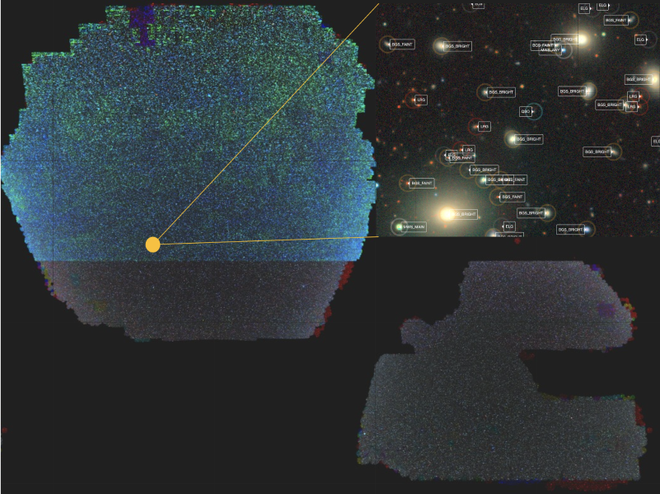China announced an extremely giant 2D map of the universe, spanning more than 10 trillion pixels
- Tram Ho
Released on January 14, this map is based on data from the Dark Energy Spectroscopy Instrument (DESI) project.
Accordingly, nearly 200 researchers and collaborators from the National Astronomical Observatory of the Chinese Academy of Sciences (NAOC) and DESO have observed galaxies in the visible universe over the past six years. These data were then analyzed to stitch the images together, creating a giant 2D map of the universe that digitally spans more than 10 trillion pixels, containing about 2 billion celestial objects.
Reportedly, the scientists made about 1405 nights of observations using three different ground telescopes, combined with the amount of data in years obtained from space telescopes. As a result, they generated the amount of data up to 1 PB, equivalent to 1000 TB.

Over the next five years, the team will create a giant three-dimensional map of the coming universe by measuring the distance between the galaxies and the speed at which they travel away from us. This map is expected to help solve the dark energy mysteries.
“We know that the universe today is accelerating its expansion. According to existing theories, the ‘power’ that drives the expansion of the universe is dark energy. However, if the nature of energy is not known. So how can we study it? The way we used it was to measure the large-scale redshift of galaxies and the 3D distribution of cosmic materials “, Zhao Gongbo, NAOC deputy director, also DESI team member, said.
Most recently, a new galaxy map has been released by Japanese astronomers showing that the Solar System is only about 25,800 light-years from the center of the Milky Way. This is significantly shorter than the 27,700 light-years figure accepted by the International Astronomical Federation (IAU) in 1985.
However, this change does not mean that the Earth is approaching the super black hole Sagittarius A * more than 4 million times the mass of the Sun in the center of the Milky Way. Instead, this new galaxy map helps to more accurately pinpoint the position of the solar system compared to the surrounding ‘neighboring’ stars.
According to the latest calculations by Japanese astronomers, the rotation speed of the solar system around the center of the Milky Way is also faster than previous calculations. Specifically, the Solar System travels at a speed of 227 kilometers per second, 7 kilometers faster than the current official speed given by the IAU.
It is known that the adjustment in terms of data is made after more than 15 years of continuous observation by scientists in the radio astronomy project called VERA.
Refer to Xinhue
Source : Genk
